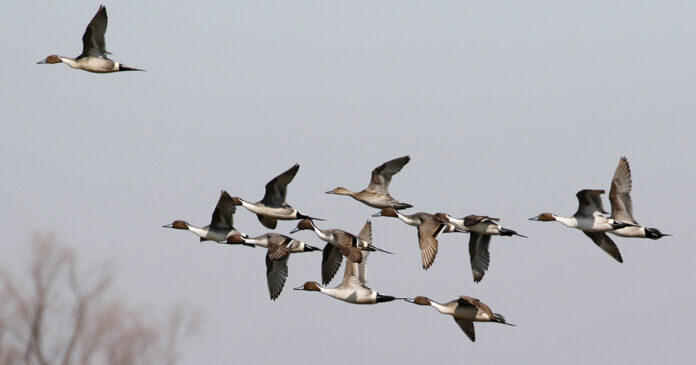
BY PETER OTTESEN
California Migration Editor – Ducks Unlimited
An early-December storm that dropped up to 12 inches of rain in some parts of the Sacramento Valley triggered fog events and helped move ducks and geese around the entire 500-mile length of the Central Valley. Overall, hunting remains slow but is showing signs of improvement.
“We got our leased rice fields near Davis flooded this week, and the ducks have responded,” reports field scout Sim Risso, who hunts south of Interstate 80. “It depends on the day what species we encounter, but there are good numbers of shovelers, green-winged teal, wigeon, gadwalls, and a surprising number of mallards—an indication the local hatch was good. We are not seeing so many pintails.” Clubs near the Yolo Bypass Wildlife Area seem to be taking advantage of birds going and coming from the closed zone.
In the Butte Sink, green-winged teal and wigeon dominate the harvest. Northern pintails, which usually pile into this legendary region, have been pretty scarce. White-fronted geese have made a strong showing and snows and Ross’s geese are congregating in rice fields north of the sink. Some clubs and public areas were flooded by the season’s first heavy rain, but most have reopened after excess water receded.
Sacramento National Wildlife Refuge (NWR) is yielding the best goose hunting among all public areas, while Delevan NWR is a leading destination for ducks. Rice blinds have encountered very sporadic action, and most hunters are crying the blues. The birds really dispersed after the big rains, and light geese are numerous north of Colusa.
Some of the Delta islands west of Stockton are literally covered with Aleutian cackling geese. More whitefronts are piling into harvested cornfields to glean the leftovers. Locally reared mallards and wood ducks are the most common ducks, but new arrivals such as green-winged teal and wigeon have added to the bag.
The Suisun Marsh, among the largest historic brackish wetlands on the West Coast, seems to be holding plenty of ducks, but they don’t move much in the morning hours. Grizzly Island Wildlife Area has been giving up few ducks, with better going in the afternoons when shovelers and wigeon take to wing. Joice Island, normally a closed area that is literally covered with ducks, opens periodically for public hunting. December 1 was the first hunt of the season, and the average per-gun harvest topped five birds per hunter, headlined by mallards and greenwings. Check local regulations to apply for the infrequent Joice Island shoots. You might get a lucky draw.
In the Grasslands Ecological Area, the West’s largest wetland complex, private clubs are taking advantage of new birds, primarily green-winged teal, shovelers, and ring-necked ducks. South of Highway 152, field scout Dennis Campini reports that canvasbacks and wigeon have arrived, an indicator that northern birds are pushing south.
Near Gustine, greenwings and shovelers top the bag on private clubs. Field scout Paul McHaney says, “There aren’t that many ducks, so you’ve got to be patient and stay in the blind until about noon. If you do, expect teal, wigeon, spoonies, and even the occasional pintail.”
Mendota Wildlife Area has been mostly tough going, with shovelers and greenwings topping the sparse fare. Farther south at Kern NWR, daily averages remain better than 2.5 birds per gun, the top public area in the Central Valley, with shovelers and gadwalls being most prominent in the bag.
Be sure to check local regulations for updates on the use of spinning-wing decoys and season dates.



